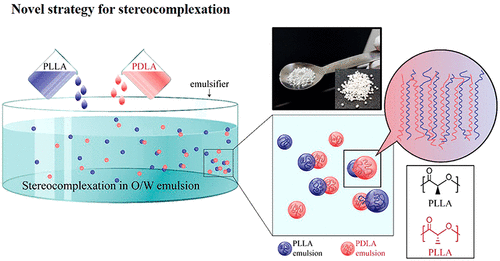当前位置:
X-MOL 学术
›
ACS Sustain. Chem. Eng.
›
论文详情
Our official English website, www.x-mol.net, welcomes your
feedback! (Note: you will need to create a separate account there.)
Strategy for Stereocomplexation of Polylactide Using O/W Emulsion Blending and Applications as Composite Fillers, Drug Carriers, and Self-Nucleating Agents
ACS Sustainable Chemistry & Engineering ( IF 7.1 ) Pub Date : 2020-05-18 , DOI: 10.1021/acssuschemeng.0c02503 Seung Hyuk Im 1, 2 , Su Jeong Park 1, 2 , Youngmee Jung 2, 3 , Justin J. Chung 2 , Soo Hyun Kim 1, 2, 3
ACS Sustainable Chemistry & Engineering ( IF 7.1 ) Pub Date : 2020-05-18 , DOI: 10.1021/acssuschemeng.0c02503 Seung Hyuk Im 1, 2 , Su Jeong Park 1, 2 , Youngmee Jung 2, 3 , Justin J. Chung 2 , Soo Hyun Kim 1, 2, 3
Affiliation

|
Biodegradable polymer polylactide (PLA) can form stereocomplex crystals through racemic blending between poly(l-lactide) (PLLA) and poly(d-lactide) (PDLA). This stereocomplexation could lead to substantially improved mechanical and physical strengths for PLA. Various methods for preparing stereocomplex PLA (sc-PLA) have been studied, e.g., solution blending, melt blending, and supercritical fluid (SCF) technology. However, current methods inevitably have various drawbacks including poor efficiency, usability, and low stereocomplexation reaction speeds. Thus, the aim of this study is to develop a novel strategy using oil-in-water (O/W) emulsion blending to overcome the current limitations of stereocomplexation. Our results indicate that the developed strategy can considerably improve the efficiency and accessibility of stereocomplex crystal formation compared to conventional methods such as solution blending and SCF technology. The O/W emulsion blending method exhibits a stereocomplexation efficiency of up to nearly 99%. Additionally, the sc-PLA produced by O/W emulsion blending can act as filler in PLA composites, leading to improvement of their mechanical properties. In addition, a cancer drug such as fluorouracil (5-FU) could be infiltrated into sc-PLA during stereocomplexation induced by O/W emulsion blending. Furthermore, sc-PLA with 5-FU prepared by the novel method could be added for ISN-polymerization in order to give both a nucleating effect and an anticancer effect. It suggests that sc-PLA prepared by our novel method could act as a stable carrier for secondary molecules as well as nucleating agents.
中文翻译:

使用O / W乳液共混的聚乳酸立体复合策略及其作为复合填料,药物载体和自成核剂的应用
可生物降解的聚合物聚丙交酯(PLA)可通过聚(l-丙交酯)(PLLA)和聚(d)之间的外消旋共混形成立体复合晶体-丙交酯(PDLA)。这种立体复合物可以导致PLA的机械强度和物理强度大大提高。已经研究了制备立体复合物PLA(sc-PLA)的各种方法,例如溶液共混,熔融共混和超临界流体(SCF)技术。然而,当前的方法不可避免地具有各种缺点,包括效率低,易用性和低的立体络合反应速度。因此,本研究的目的是开发一种使用水包油(O / W)乳液共混的新策略,以克服目前立体复合的局限性。我们的结果表明,与常规方法(例如溶液混合和SCF技术)相比,该开发的策略可以显着提高立体复杂晶体形成的效率和可及性。O / W乳液共混方法的立体复合效率高达近99%。此外,通过O / W乳液共混生产的sc-PLA可以充当PLA复合材料的填料,从而改善其机械性能。此外,在O / W乳液共混诱导的立体复合过程中,诸如氟尿嘧啶(5-FU)等抗癌药物可能会渗入sc-PLA。此外,可以添加通过该新方法制备的具有5-FU的sc-PLA用于ISN聚合,以便同时给出成核作用和抗癌作用。这表明通过我们的新方法制备的sc-PLA可以充当二级分子和成核剂的稳定载体。导致其机械性能的改善。此外,在O / W乳液共混引起的立体复合过程中,诸如氟尿嘧啶(5-FU)之类的抗癌药物可能会渗入sc-PLA。此外,可以添加通过该新方法制备的具有5-FU的sc-PLA用于ISN聚合,以便同时给出成核作用和抗癌作用。这表明通过我们的新方法制备的sc-PLA可以充当二级分子和成核剂的稳定载体。导致其机械性能的改善。此外,在O / W乳液共混诱导的立体复合过程中,诸如氟尿嘧啶(5-FU)等抗癌药物可能会渗入sc-PLA。此外,可以添加通过该新方法制备的具有5-FU的sc-PLA用于ISN聚合,以便同时给出成核作用和抗癌作用。这表明通过我们的新方法制备的sc-PLA可以充当二级分子和成核剂的稳定载体。
更新日期:2020-05-18
中文翻译:

使用O / W乳液共混的聚乳酸立体复合策略及其作为复合填料,药物载体和自成核剂的应用
可生物降解的聚合物聚丙交酯(PLA)可通过聚(l-丙交酯)(PLLA)和聚(d)之间的外消旋共混形成立体复合晶体-丙交酯(PDLA)。这种立体复合物可以导致PLA的机械强度和物理强度大大提高。已经研究了制备立体复合物PLA(sc-PLA)的各种方法,例如溶液共混,熔融共混和超临界流体(SCF)技术。然而,当前的方法不可避免地具有各种缺点,包括效率低,易用性和低的立体络合反应速度。因此,本研究的目的是开发一种使用水包油(O / W)乳液共混的新策略,以克服目前立体复合的局限性。我们的结果表明,与常规方法(例如溶液混合和SCF技术)相比,该开发的策略可以显着提高立体复杂晶体形成的效率和可及性。O / W乳液共混方法的立体复合效率高达近99%。此外,通过O / W乳液共混生产的sc-PLA可以充当PLA复合材料的填料,从而改善其机械性能。此外,在O / W乳液共混诱导的立体复合过程中,诸如氟尿嘧啶(5-FU)等抗癌药物可能会渗入sc-PLA。此外,可以添加通过该新方法制备的具有5-FU的sc-PLA用于ISN聚合,以便同时给出成核作用和抗癌作用。这表明通过我们的新方法制备的sc-PLA可以充当二级分子和成核剂的稳定载体。导致其机械性能的改善。此外,在O / W乳液共混引起的立体复合过程中,诸如氟尿嘧啶(5-FU)之类的抗癌药物可能会渗入sc-PLA。此外,可以添加通过该新方法制备的具有5-FU的sc-PLA用于ISN聚合,以便同时给出成核作用和抗癌作用。这表明通过我们的新方法制备的sc-PLA可以充当二级分子和成核剂的稳定载体。导致其机械性能的改善。此外,在O / W乳液共混诱导的立体复合过程中,诸如氟尿嘧啶(5-FU)等抗癌药物可能会渗入sc-PLA。此外,可以添加通过该新方法制备的具有5-FU的sc-PLA用于ISN聚合,以便同时给出成核作用和抗癌作用。这表明通过我们的新方法制备的sc-PLA可以充当二级分子和成核剂的稳定载体。











































 京公网安备 11010802027423号
京公网安备 11010802027423号